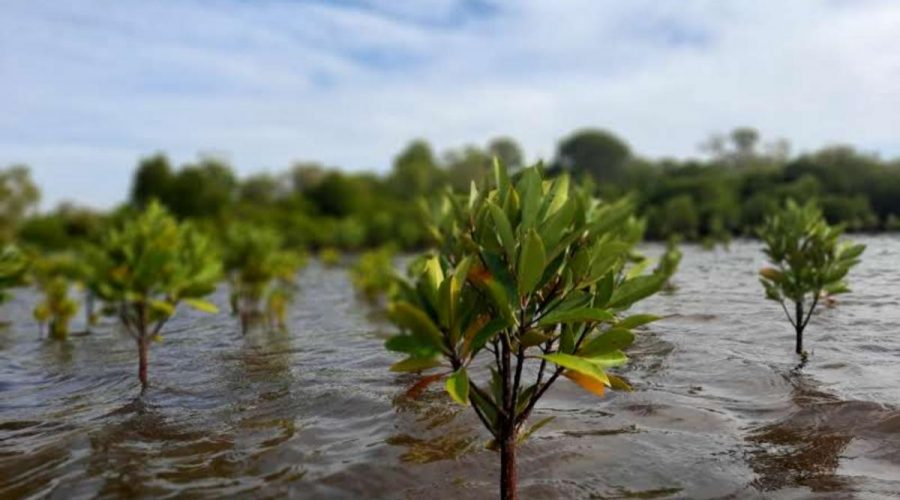- Carbon credit debates at COP26 demonstrated how difficult it is to apply a global standard to complex regulatory and natural landscapes, particularly physical landscapes, across diverse geographies.
- When it comes to environmental protection, carbon credits should not be viewed in isolation: the forests, biodiversity, and communities that nature-based climate solutions support must also be considered.
- Restorasi Ekosistem Riau is not only one of the last intact peatland forests on the planet, but it is also an example of the successful integration of biodiversity, community, and climate strategies and actions.
Carbon credits are a commodity that can be traded and valued. They are also a predictor of investment rates in climate and nature. Carbon credit discussions at the COP26 meeting in Glasgow were ultimately inconclusive, but they demonstrated how difficult it is to apply a global standard to complex regulatory and physical landscapes across diverse geographies.
This broader point is frequently overlooked in discussions about carbon credits. Carbon credits, whether the result of avoidance, reduction, or removal, should not be viewed in isolation: the forests, biodiversity, and communities that nature-based climate solutions support are also critical components of the equation.
Have you read it?
- Why will hydrogen continue to be a carbon-intensive solution until we can produce it cleanly?
- This is how Dhaka’s river ecosystems can be restored.
- How investing in nature can aid in the fight against the biodiversity and climate crises
Forests become carbon sinks when they absorb more carbon than they emit. Carbon sinks act as a carbon store that can be measured and valued, and then potentially offset against emissions from other activities.
But that’s only half of the story. In landscapes like Indonesia’s tropical swamp forests, where natural forest protection is critical for biodiversity and wildlife, it is also critical to sustain the communities that rely on forests for ecosystem services and livelihoods. While the scientific relationship between the two is complex, carbon, biodiversity, and community are inseparable on the forest floor.
Landscapes that deliver multiple benefits
Restorasi Ekosistem Riau (RER), a peat swamp forest restoration project led by APRIL Group, is one example. The project has been registered with Verra and has the potential to be one of the largest carbon projects in the world, generating approximately 6.8 million tonnes of carbon credits per year. However, with over 150,000 hectares – an area the size of Greater London – located on the Kampar Peninsula and neighboring Padang Island in Riau Province, RER is an entire landscape that provides multiple benefits.
Following many years of forest restoration and active protection in collaboration with organizations such as Fauna & Flora International, the true biodiversity benefits of taking a landscape approach have emerged. These include an increasing species count, with 823 plant and animal species recorded in the restoration area in 2020, many of which are classified as being of conservation concern by the IUCN. This was an increase from 797 the previous year. Sumatran tigers, including one that was rescued and reintroduced to the landscape last year as part of a multi-stakeholder effort, as well as other rare indigenous wildlife, such as the flat-headed cat, have been spotted and studied using camera traps.
Communities in and around the restoration forest play an important role, which is supported by respectful engagement and education. RER has its own economic and ecological ecosystem, where communities are engaged as active partners, from improving fishing practices to maintaining livelihood catches while increasing water quality within the restoration area, to the sustainable production of forest honey and other forest products for commercial sale, to providing employment as forest rangers to guard against encroachment, wildlife poaching, and fire.
RER has the potential to be a one-of-a-kind location for groundbreaking scientific research. Its eco-research camp and other facilities set up on the restoration area’s borders allow scientists from all over the world to conduct their own research. The site can serve as a tropical peatland science laboratory, leveraging and improving existing data on greenhouse gas emissions, hydrology, and flora and fauna surveys conducted at the landscape level.
Protecting and restoring forest areas benefits multiple values, and stored carbon will contribute significantly to funding this important work. The production-protection approach used by RER, in which the conservation area is surrounded by a ring of plantations, means that sustainable plantations support the technical and financial capabilities required for large-scale conservation and restoration. In this case, the value generated by this carbon store will be reinvested in restoration and conservation efforts.
A catalyst for landscape protection
RER is significant not only because it contains one of the last intact peatland forests. It also exemplifies the successful integration of biodiversity, community, and climate strategies and actions, as well as private-public-NGO collaboration.
Unfortunately, biodiversity lacks a commitment like the 1.5-degree Celsius climate target or an equivalent “net zero” unifying goal. This makes it more difficult to monitor and assess progress in a globally accepted manner. The Post-2020 Global Biodiversity Framework of the Convention on Biological Diversity, as well as the work of the Science Based Targets Network to align SBTs with the Framework and the Sustainable Development Goals, may provide more answers. However, this is not an excuse to put off taking action. Restoring and protecting forests is widely acknowledged as one of the most cost-effective carbon-reduction strategies. The advantages of well-managed forest protection and restoration for biodiversity are obvious.
What are voluntary carbon markets?
Carbon credits can be used to fund additional forest conservation and restoration while also offsetting emissions from business activities. While the monetary value of carbon credits can be expressed, equal consideration for nature’s biodiversity and community health reveals the true value and commitment to conservation. Where the two are inextricably linked, it is the investment in restoration and conservation that generates carbon value and yields a return in biodiversity gain. Decoupling carbon from its context and treating it as a commodity may jeopardize the biodiversity and community engagement that sustain and grow its value.




